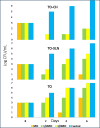Antibacterial effects of thyme oil loaded solid lipid and chitosan nano-carriers against Salmonella Typhimurium and Escherichia coli as food preservatives
- PMID: 39739777
- PMCID: PMC12140078
- DOI: 10.1371/journal.pone.0315543
Antibacterial effects of thyme oil loaded solid lipid and chitosan nano-carriers against Salmonella Typhimurium and Escherichia coli as food preservatives
Abstract
Objectives: Escherichia coli and Salmonella Typhimurium are frequent causes of foodborne illness affecting many people annually. In order to develop natural antimicrobial agents against these microorganisms, thyme oil (TO) was considered as active antibacterial ingredient. TO contains various bioactive compounds that exhibit antimicrobial properties. To increase the antibacterial effects and stability of thyme oil, two promising carrier systems, solid lipid nanoparticles (SLN) and chitosan nanoparticles have been fabricated in this study.
Methods: Nanoparticles were made using natural-based lipids and polymers by a probe sonication method. They were characterized using infrared spectrometry (FTIR), transmission electron microscopy (TEM), particle size, cytotoxicity, etc. Antibacterial effects of TO, thyme oil loaded in SLN (TO-SLN) and thyme oil loaded in chitosan nanoparticle (TO-CH) was evaluated against E. coli and S. typhimurium using Minimum inhibitory/bactericidal concentrations (MIC/MBC) determination. Encapsulation efficiency (EE%) and drug release profile were also studied in vitro.
Results: TEM analysis revealed spherical/ovoid-shaped particles with clear edges. TO-SLN had an average size of 42.47nm, while TO-CH had an average size of 144.8nm. The Encapsulation efficiency of TO-CH and TO-SLN nanoparticles were about 81.6±1% and 73.4±1%, respectively. Results indicated 92% cumulative release in TO-CH in comparison with 88% in TO-SLN in 72 h. MIC against E. coli and S. typhimurium for TO-CH, TO-SLN, and pure TO were 4 and 1.5 μg/mL, 60 and 40 μg/mL, and 180-150 μg/mL, respectively.
Conclusion: Nanoencapsulation of thyme oil significantly potentiated its antimicrobial effects. TO-CH exhibited a significantly higher antibacterial effect compared to TO-SLN (6-fold) and pure thyme oil (more than 10-fold).
Copyright: © 2024 Monsef et al. This is an open access article distributed under the terms of the Creative Commons Attribution License, which permits unrestricted use, distribution, and reproduction in any medium, provided the original author and source are credited.
Conflict of interest statement
The authors have declared that no competing interests exist.
Figures






Similar articles
-
SLN and chitosan nano-delivery systems for antibacterial effect of black seed (Nigella sativa) oil against S. aureus.Int J Environ Health Res. 2025 Apr;35(4):991-1002. doi: 10.1080/09603123.2024.2378103. Epub 2024 Jul 21. Int J Environ Health Res. 2025. PMID: 39033513
-
Chitosan nanoparticles loaded with clove essential oil: Characterization, antioxidant and antibacterial activities.Carbohydr Polym. 2020 May 15;236:116075. doi: 10.1016/j.carbpol.2020.116075. Epub 2020 Feb 26. Carbohydr Polym. 2020. PMID: 32172888
-
Release study and inhibitory activity of thyme essential oil-loaded chitosan nanoparticles and nanocapsules against foodborne bacteria.Int J Biol Macromol. 2017 Oct;103:409-414. doi: 10.1016/j.ijbiomac.2017.05.063. Epub 2017 May 16. Int J Biol Macromol. 2017. PMID: 28526346
-
Formulation of Cinnamon (Cinnamomum verum) oil loaded solid lipid nanoparticles and evaluation of its antibacterial activity against Multi-drug Resistant Escherichia coli.BMC Complement Med Ther. 2022 Nov 9;22(1):289. doi: 10.1186/s12906-022-03775-y. BMC Complement Med Ther. 2022. PMID: 36352402 Free PMC article.
-
Antibacterial Activity of Epigallocatechin-3-gallate (EGCG) Loaded Lipid-chitosan Hybrid Nanoparticle against Planktonic Microorganisms.J Oleo Sci. 2024;73(5):709-716. doi: 10.5650/jos.ess23155. J Oleo Sci. 2024. PMID: 38692893
Cited by
-
Nano-encapsulated Melissa officinalis Essential Oil and Its Antibacterial Effects Against Multi Drug Resistant E. coli and K. pneumonia.Curr Microbiol. 2025 May 2;82(6):271. doi: 10.1007/s00284-025-04157-6. Curr Microbiol. 2025. PMID: 40314784
References
-
- Brock TD, Madigan MT, Martinko JM, Parker J. Brock biology of microorganisms: Upper Saddle River (NJ): Prentice-Hall, 2003.; 2003.
MeSH terms
Substances
LinkOut - more resources
Full Text Sources
Medical

